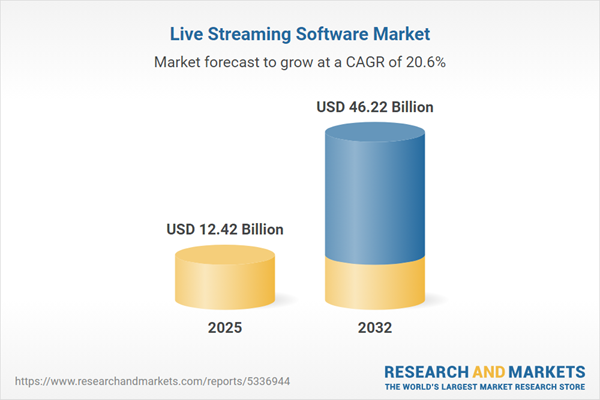Speak directly to the analyst to clarify any post sales queries you may have.
The live streaming software market is evolving rapidly, providing enterprises and content creators with innovative tools for real-time engagement, scalable content delivery, and increased monetization opportunities.
Market Snapshot: Live Streaming Software Market Growth and Outlook
The Live Streaming Software Market grew from USD 10.33 billion in 2024 to USD 12.42 billion in 2025. It is expected to continue growing at a CAGR of 20.59%, reaching USD 46.22 billion by 2032.
Scope & Segmentation: Technologies, Solutions, and Geographies
- Components: Managed services, professional services, support maintenance, analytics tools, CDN management, encoder-transcoder, video management platforms
- Streaming Types: Hybrid streaming, live streaming, video-on-demand (VOD)
- Deployment Models: Cloud, hybrid, on-premises
- End Uses: Education and training, enterprise communications, events and conferencing, marketing webinars, gaming and eSports, media and entertainment, social media, live interaction, social commerce
- Regions Covered: North America, Latin America, Europe, Middle East and Africa, Asia-Pacific
- Key Technologies: Artificial intelligence, machine learning, cloud-native platforms, edge computing, advanced encryption and DRM, real-time analytics, HTTP live streaming protocols, 5G-enabled broadcast infrastructure
Key Takeaways for Senior Decision-Makers
- The live streaming software market is driven by digital transformation, with emphasis on agile, interactive, and compliant video solutions.
- Scalability, security, and low-latency delivery are top priorities shaping technology selection and vendor partnerships.
- AI-powered analytics and personalized content are increasingly used to refine audience segmentation and boost engagement.
- Adoption of cloud and hybrid models enables flexible workloads, while edge computing supports latency-sensitive and mission-critical streams.
- Cohesive integration with social media and e-commerce platforms is unlocking new monetization avenues for brands and content creators.
- Organizations adopting open APIs and robust managed services enhance extensibility and operational transparency.
Tariff Impact: Navigating 2025 Trade Policy Changes
Recent United States tariffs on imported hardware and select software modules have prompted market participants to revise procurement and supply chain strategies. These shifts are driving some vendors to explore nearshore manufacturing, diversify supplier partnerships, and renegotiate contracts to maintain stable operations and mitigate margin pressures. Firms must evaluate master service agreements and modular architectures to remain competitive under evolving cost structures.
Methodology & Data Sources
This report synthesizes data from industry publications, primary interviews with sector executives, and surveys of solution architects and enterprise leaders. Secondary analysis of technical white papers, regulatory filings, conference records, and trade policies ensured comprehensive scenario validation. Rigorous cross-referencing and triangulation underpin the accuracy of insights presented here.
Why This Report Matters: Decision-Ready Insights for Stakeholders
- Clarifies how live streaming software advances operational efficiency and audience growth across multiple sectors and deployment models.
- Delivers actionable intelligence to inform technology investments, vendor selection, and compliance strategies in dynamic regulatory environments.
- Empowers strategic planning for global, regional, and industry-specific expansion in the competitive live streaming ecosystem.
Conclusion
The live streaming software market is defined by rapid technological progress, nuanced segmentation, and shifts in global trade dynamics. Organizations that align flexible architectures with evolving market trends will secure measurable engagement and monetization gains.
Additional Product Information:
- Purchase of this report includes 1 year online access with quarterly updates.
- This report can be updated on request. Please contact our Customer Experience team using the Ask a Question widget on our website.
Table of Contents
3. Executive Summary
4. Market Overview
7. Cumulative Impact of Artificial Intelligence 2025
List of Figures
Samples

LOADING...
Companies Mentioned
The key companies profiled in this Live Streaming Software market report include:- YouTube, LLC
- Twitch Interactive, Inc.
- Meta Platforms, Inc.
- Zoom Video Communications, Inc.
- Streamlabs Inc.
- Restream, Inc.
- StreamYard LLC
- SplitmediaLabs Inc.
- Brightcove Inc.
- Vimeo, Inc.
Table Information
| Report Attribute | Details |
|---|---|
| No. of Pages | 190 |
| Published | October 2025 |
| Forecast Period | 2025 - 2032 |
| Estimated Market Value ( USD | $ 12.42 Billion |
| Forecasted Market Value ( USD | $ 46.22 Billion |
| Compound Annual Growth Rate | 20.5% |
| Regions Covered | Global |
| No. of Companies Mentioned | 11 |









